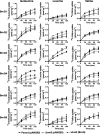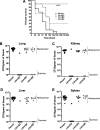BrnQ-Type Branched-Chain Amino Acid Transporters Influence Bacillus anthracis Growth and Virulence
- PMID: 35073743
- PMCID: PMC8787487
- DOI: 10.1128/mbio.03640-21
BrnQ-Type Branched-Chain Amino Acid Transporters Influence Bacillus anthracis Growth and Virulence
Abstract
Bacillus anthracis, the anthrax agent, exhibits robust proliferation in diverse niches of mammalian hosts. The metabolic attributes of B. anthracis that permit rapid growth in multiple mammalian tissues have not been established. We posit that branched-chain amino acid (BCAA) (isoleucine, leucine, and valine) metabolism is key to B. anthracis pathogenesis. Increasing evidence indicates the relationships between B. anthracis virulence and the expression of BCAA-related genes. The expression of some BCAA-related genes is altered during culture in bovine blood in vitro, and the bacterium exhibits valine auxotrophy in a blood serum mimic medium. Transcriptome analyses have revealed that the virulence regulator AtxA, which positively affects the expression of the anthrax toxin and capsule genes, negatively regulates genes predicted to be associated with BCAA biosynthesis and transport. Here, we show that B. anthracis growth in defined medium is severely restricted in the absence of exogenous BCAAs, indicating that BCAA transport is required for optimal growth in vitro. We demonstrate functional redundancy among multiple BrnQ-type BCAA transporters. Three transporters are associated with isoleucine and valine transport, and the deletion of one, BrnQ3, attenuates virulence in a murine model for anthrax. Interestingly, an ilvD-null mutant lacking dihydroxy acid dehydratase, an enzyme essential for BCAA synthesis, exhibits unperturbed growth when cultured in medium containing BCAAs but is highly attenuated in the murine model. Finally, our data show that BCAAs enhance AtxA activity in a dose-dependent manner, suggesting a model in which BCAAs serve as a signal for virulence gene expression. IMPORTANCE Infection with B. anthracis can result in systemic disease with large numbers of the bacterium in multiple tissues. We found that branched-chain amino acid (BCAA) synthesis is insufficient for the robust growth of B. anthracis; access to BCAAs is necessary for the proliferation of the pathogen during culture and during infection in a murine model for anthrax. B. anthracis produces an unusually large repertoire of BCAA-related transporters. We identified three isoleucine/valine transporters with partial functional redundancy during culture. The deletion of one of these transporters, BrnQ3, resulted in attenuated virulence. Interestingly, a BCAA biosynthesis mutant grew well in medium containing BCAAs but, like BrnQ3, was attenuated for virulence. These results suggest that BCAAs are limiting in multiple niches during infection and further our understanding of the nutritional requirements of this important pathogen.
Keywords: Bacillus; amino acid transport; anthracis; anthrax; branched-chain amino acid; nutritional immunity; virulence regulation.
Conflict of interest statement
The authors declare no conflict of interest.
We declare no competing interests.
Figures










References
Publication types
MeSH terms
Substances
Grants and funding
LinkOut - more resources
Full Text Sources
Other Literature Sources
Medical

